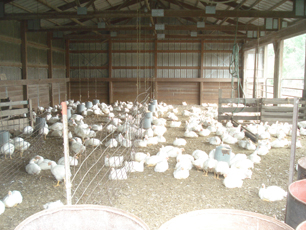G2160
Good Management Practices for Youth
Injury
As a good and responsible livestock producer, you are providing excellent care for your animal on a full-time basis. Below are sound production practices to help your animal thrive in your care. In addition, a checklist has been provided to make sure you follow these guidelines prior to and while at fairs and other public exhibitions.
This is No. 5 in a series of seven documents on good management practices for youth. Copies of these documents, commonly asked questions, feed and water requirements, and many other animal care and well-being documents can be accessed at http://4h.unl.edu/resourceanimalcare.
Lindsay M. Chichester, Extension Educator
Dennis E. Bauer, Extension Educator
|
Prior to Fair
Animals are naturally curious and can unintentionally injure themselves or others. When animals get frisky and play, they also may be putting themselves in danger of an injury if their pen or space is not clear of all potential dangers and debris. You should continuously check pen and shelter structures. Look for sharp edges, broken glass, nails, jagged tin, wire, trash, and rocks. Remove or fix anything that could cause your animal or you potential harm.
If you notice that your animal has either injured itself or has possibly eaten something it should not have, you should immediately contact a parent/guardian, leader, or veterinarian. They can help you make a rapid diagnosis and provide necessary treatment. If your animal needs treatment, make sure you follow proper label and withdrawal instructions.
As a good youth producer, I know that prior to fair my animal has received:
- a pen or shelter area free of possible dangers that may cause injury,
- an accurate and quick diagnosis of disease (if applicable) from a veterinarian, leader, or parent/guardian, and
- a treatment plan (if necessary).
While at Fair
When you put your animal in its new location at fair, check the area to ensure there are no possible dangers. These may include, but are not limited to, nails, staples, tacks, pieces of wire or wood, or any small object your animal could eat. Remove or fix anything that could cause harm.
As a good youth producer, I know that at fair my animal has received:
- a pen or shelter area free of possible dangers that could cause injury,
- an accurate and quick diagnosis of disease (if applicable) from a veterinarian, leader, or parent/guardian, and
- a plan for a treatment (if applicable).
By following these guidelines prior to and during fairs and exhibitions, you can minimize stress for both you and your animal. In return, your animal not only will perform better but also will behave better. You will have the satisfaction of knowing that you have provided the best possible care for your animal.
Annually, Nebraska’s youth are required to complete Quality Assurance (QA) training. Quality Assurance is a program that educates youth about the best management practices for livestock production. In addition, it was developed to assure consumers that the food products produced from animals are wholesome and safe, and that the animals that produced the product were cared for properly. In 2012, this training also was made available online for 4-H and FFA members at three different age levels: Junior (8-10); Intermediate (11-14); and Senior (15-18). More information about the Nebraska Youth QA Program can be found at http://4h.unl.edu/qualityassurance.
This publication has been peer reviewed.
Visit the University of Nebraska–Lincoln Extension Publications website for more publications.
Index: Animals, General
Management
Issued June 2012
